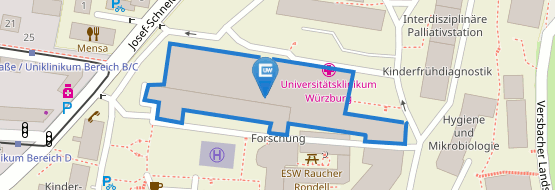Arbeitsgruppe Spahn - Nanoscale Bacteriology

Willkommen auf der Seite der Forschungsgruppe "Nanoscale Bacteriology"!
Im Nanoscale Bacteriology Lab untersuchen wir die molekulare Organisation von Bakterien. Hierzu verwenden wir verschiedene Mikroskopie-Methoden, allen voran Höchstauflösende Mikroskopie. Diese Gruppe von Mikroskopiemethoden ermöglicht es, Bilder von biologischen Proben und Strukturen mit einer Auflösung von wenigen Nanometern zu erzeugen. Im Vergleich zu konventioneller Lichtmikroskopie (z.B. Weitfeld- oder konfokale Fluoreszenzmikroskopie) stellt dies eine Auflösungsverbesserung um den Faktor 10 - 30 dar. Dies ermöglicht uns, Proteine, Nukleinsäuren und andere Biomoleküle auf nahezu molekularer Ebene und im Kontext intakter, einzelner Zellen zu untersuchen.
Da die Möglichkeiten für die mehrfarbige Höchstauflösende Fluoreszenzmikroskopie in Bakterien begrenzt sind, etablieren und entwickeln wir Methoden, die die gleichzeitige Visualisierung verschiedener Ziele ermöglichen. Dazu gehören Einzelmolekül-basierte Techniken (Single-molecule localization microscopy, SMLM), STED-Mikroskopie und Lebendzell-Mikroskopie. In Verbindung mit künstlicher Intelligenz liefern diese Markierungs- und Bildgebungsverfahren umfangreiche Informationen zu diversen biologischen Fragestellungen. Wir sind auch an der Entwicklung intelligenter Mikroskopieverfahren interessiert, welche z.B. Hochdurchsatzmikroskopie im Bereich der Wirkstoffentdeckung verfeinert und beschleunigt.
Biologisch liegt ein Hauptaugenmerk der Gruppe auf der Untersuchung der Transertion. Transertion beschreibt eine Kopplung von Transkription, Translation und Insertion von Membranproteinen, ein postulierter aber noch unzureichend aufgeklärter Mechanismus, der die bakterielle chromosomale DNA (das sogenannte Nukleoid) dynamisch mit der Bakterienmembran verbindet. Da Bakterienzellen winzig sind, erfordert die Untersuchung dieses Prozesses eine räumliche Auflösung im Nanometerbereich. Durch systematische Störungen der zellulären Prozesse mit Antibiotika konnte gezeigt werden, dass die Proteinbiosynthese stark zur Organisation des bakteriellen Nukleoids beiträgt. In unserer zukünftigen Arbeit wollen wir die molekularen Mechanismen hinter dieser Organisation entschlüsseln, sowohl in unserem Modellorganismus Escherichia coli, als auch in gram-negativen Krankheitserregern.
Insgesamt ermöglicht unser breites Methodenspektrum zukünftig die Untersuchung diverser weiterer biologischer Fragestellungen. Hierzu gehören unter Anderem:
- Aufbau bakterieller Biofilme
- Mikrobielle Resistenzmechanismen
- Pathogen-Wirtszell-Interaktionen

- Spahn, C., Middlemiss, S., Gómez-de-Mariscal, E., Henriques, R., Bode, H. B., Holden, S., Heilemann, M., “Transertion and cell geometry organize the Escherichia coli nucleoid during rapid growth.” bioRxiv 2023.10.16.562172 [link]
- Pandi, A., Adam, D., Zare, A., Trinh, V.T., Schaefer, S.L., Wiegand, M., Klabunde B., Bobkova, E., Kushwaha, M., Foroughijabbari, Y., Braun, P., Spahn, C., Preußer, C., von Strandmann, E.P., Bode, H.B., von Buttlar, H., Bertrams, W., Jung, A.L., Abendroth, F., Schmeck, B., Hummer, G., Vázquez, O., Erb, T.J. “Cell-free biosynthesis combined with deep learning accelerates de novo-development of antimicrobial peptides.” Nat. Commun. 14, 7197 (2023) [link]
- Spahn, C., Gómez-de-Mariscal, E., Laine, F.L., Pereira, P. M., von Chamier, L., Condiut, M., Pinho, M.G., Jacquemet, G., Holden, S., Heilemann, M. & Henriques, R., “DeepBacs for multi-task bacterial image analysis using open-source deep learning approaches.” Commun. Biol. 5, 688 (2022) [link]
- Koller, N., Höllthaler, P., Barends, M., Döring, M, Spahn, C., Durán, V., Costa, B., Becker, J., Heilemann, M., Kalinke, U., Tampé, R., “Nanoscale organization of the MHC I peptide-loading complex in human dendritic cells.” Cell. Mol. Life Sci. 79(9):477 (2022) [link]
- Chamier, v.L.#, Laine#, R.F., Jukkala, J., Spahn, C., Krentzel, D., Nehme, E., Lerche, M., Hernández-Pérez, S., Mattila, P.K., Karinou, E., Holden, S., Solak, A.C., Krull, A., Buchholz, T.-O., Jones, M.L., Royer, L.A., Leterrier, C., Shechtman, Y., Jug, F., Heilemann, M., Jacquemet, G., Henriques, R., “Democratising deep learning for microscopy with ZeroCostDL4Mic.” Nature Communications 12, 2246 (2021) [link]
- Vo T.D.#, Spahn, C.#, Heilemann, M., Bode, H.B., “Microbial cationic peptides as a natural defense mechanism against insect antimicrobial peptides.” ACS Chemical Biology 16(3), pp 447-451 (2021) [link]
- Glogger, M., Spahn, C., Enderlein, J., Heilemann M., “Multi-Color, Bleaching-Resistant Super-Resolution Optical Fluctuation Imaging with Oligonucleotide-Based Exchangeable Fluorophores.” Angewandte Chemie (2020). [link]
- Spahn, C., Hurter, F., Glaesmann, M., Karathanasis, C., Lampe, M., Heilemann, M., “Protein-Specific, Multicolor and 3D STED Imaging in Cells with DNA-Labeled Antibodies.” Angewandte Chemie 58(52), pp 18835-18838 (2019). [link]
- Spahn, C., Grimm, J.B., Lavis, L.D., Lampe, M., Heilemann, M., “Whole-Cell, 3D, and Multicolor STED Imaging with Exchangeable Fluorophores.” Nano Letters 19 (1), pp 500–505 (2018). [link]
- Spahn, C.#, Glaesmann, M.#, Grimm, J.B., Ayala, A.X., Lavis, L.D., Heilemann, M., “A toolbox for multiplexed super-resolution imaging of the E. coli nucleoid and membrane using novel PAINT labels.” Scientific Reports 8, 14768 (2018). [link]
- Gao, Y.#, Spahn, C.#, Heilemann, M., Kenney, L.J., “The Pearling Transition Provides Evidence of Force-Driven Endosomal Tubulation during Salmonella Infection.” mBio 9, e01083-18 (2018). [link]
- Diekmann, R., Wolfson, D.L., Spahn, C., Heilemann, M., Schüttpelz, M. & Huser, T. “Nanoscopy of bacterial cells immobilized by holographic optical tweezers.” Nature Communications 7, 13711 (2016). [link]
- Spahn, C., Herrmannsdӧrfer, F., Kuner, T. & Heilemann, M. “Temporal accumulation analysis provides simplified artifact-free analysis of membrane-protein nanoclusters.” Nature Methods 13, 963–964 (2016). [link]
- Devraj, K., Poznanovic, S., Spahn, C., Schwall, G., Harter, P., Mittelbronn, M., Antoniello, K., Paganetti, P., Muhs, A., Heilemann, M., Hawkins, R.A., Schrattenholz, A. & Liebner, S. “BACE-1 is expressed in the blood-brain barrier endothelium and is upregulated in a murine model of Alzheimer’s disease.” Journal of Cerebral Blood Flow & Metabolism 36, 1281–1294 (2016). [link]
- Foo, Y. H.#, Spahn, C.#, Zhang, H., Heilemann, M. & Kenney, L. J. “Single cell super-resolution imaging of E. coli OmpR during environmental stress.” Integr. Biology 7, 1297–1308 (2015). [link]
- Spahn, C., Cella-Zannacchi, F., Endesfelder, U. & Heilemann, M. “Correlative super-resolution imaging of RNA polymerase distribution and dynamics, bacterial membrane and chromosomal structure in Escherichia coli.” Methods and Applications in Fluorescence 3, 014005 (2015). [link]
- Raulf, A., Spahn, C., Zessin, P. & Heilemann, M. “Click chemistry facilitates direct labelling and super-resolution imaging of nucleic acids and proteins.” RSC Advances 4, 30462–30466 (2014). [link]
- Spahn, C., Endesfelder, U. & Heilemann, M. “Super-resolution imaging of Escherichia coli nucleoids reveals highly structured and asymmetric segregation during fast growth.” Journal of Structural Biology 185 (3), 243-249 (2014). [link]
- Klehs, K., Spahn, C., Endesfelder, U., Lee, S.F., Fuerstenberg, A. & Heilemann, M. “Increasing the Brightness of Cyanine Fluorophores for Single-Molecule and Superresolution Imaging.” ChemPhysChem 15, 637–641 (2014). [link]
Dr. Christoph Spahn
Josef-Schneider-Straße 2

Kilian Andress
Haus D 15


